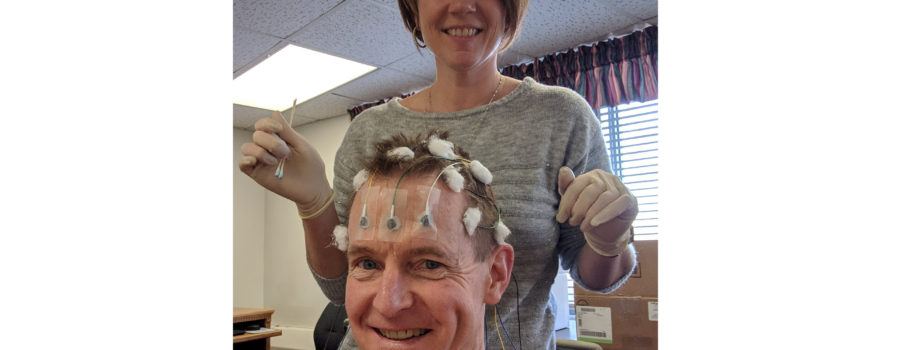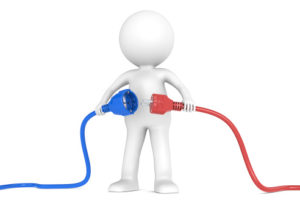To many people, including me, the phrase “interesting meeting” is usually an oxymoron. Today, that generality was proven wrong.
African children with cerebral malaria frequently have seizures. Neurologists use specific terms to refer to these abnormal events. A “convulsion” is a physical event accompanying abnormal electrical activity in the brain. The abnormal electrical activity in the brain is termed a “seizure.” Seizures can be either convulsive (there is a physical sign of the abnormal electrical activity such as stiffening, jerking, or abnormal eye movements) or non-convulsive (there are no physical signs of the electrical seizure). Convulsive seizures are easy; the doctor taking care of the child sees them and treats with anti-seizure medicines. Non-convulsive seizures are more challenging. By definition there are no physical signs of the abnormal electrical activity. They can only be detected by an EEG (brainwave) study. EEGs are obtained by technicians who painlessly apply electrodes to the scalp. They record for 30 minutes. The resulting brainwaves are interpreted by a trained neurologist.
Neurologists believe that though convulsions are scary to see, it is seizures that injure the brain and need to be urgently treated. Since it is easy to see a convulsion, identifying non-convulsive seizures early is an important aspect of the care of critically ill children. In many low-resource environments (developing countries) there are no EEG facilities. In these places, non-convulsive seizures will be undetected and, therefore, untreated. In other places, EEG machines and trained technicians are available, but there is no trained neurologist to perform interpretation. Currently, there are commercially available computer programs that can be used to detect non-convulsive seizures in EEG tracings. Unfortunately, in cerebral malaria, we have found what is currently available to be unhelpful. The software tells us there is no seizure when we can clearly see one, or the converse: the system detects a seizure when none is present. We need something better to help doctors take better care of children with cerebral malaria.
The software tells us there is no seizure when we can clearly see one, or the converse: the system detects a seizure when none is present. We need something better to help doctors take better care of children with cerebral malaria.
This was the topic of today’s non-oxymoronic interesting meeting. Our team of neurophysiologists (experts in reading EEGs) is made up of Alex Andrews, Tesfaye Zelleke, Danny Clark, and Dana Harrar. We met with two experts in machine learning to discuss this problem. We want to design a computer program that will accurately detect electrical seizures in children with cerebral malaria, even when there is no physical convulsion. This will allow doctors caring for children with this disease to treat the seizures and hopefully improve the child’s outcome. Our vision is that an EEG technician would record for 30 minutes, upload the tracing into a computer program, and the machine would compute the likelihood that the patient was having an electrical seizure.
Why is any of this needed? Malawi, a country of 18.6 million people, there is one trained pediatric neurologist. He is also the head of the country’s College of Medicine. With such a heavy load of administrative responsibilities, he cannot be available to read EEGs immediately after they are performed. Malawi is not unique. Uganda, with a population of 44 million, has two trained pediatric neurologists. Ghana (population 30 million) had two trained pediatric neurologists, but one just retired. Contrast this with the USA with a population of 329 million and 904 pediatric neurologists. In Uganda the ratio of neurologists to people is one to 22 million. In the USA it is one to 363,000 people. Those numbers are very different.
If a machine could be as accurate as a human (a big “if,” though humans are not perfect, of course) in EEG interpretation, this might solve one part of the problem. Of course, detective non-convulsive seizures in children with cerebral malaria has many challenges: purchasing EEG machines, training technicians to correctly apply EEG electrodes, and (of course) finding someone who will pay for all of this.
Of course, if I allowed this long list of challenges to deter me, I would never start trying to solve this problem. Like most people in the world, I work best when I break down a complex issue and tackle its constituent parts one by one. It is my hope that if we can figure out the technology, someone on Earth will care enough to help me figure out the other steps. We want to help children dying of malaria. Shouldn’t this disease, that kills more than 400,000 people per year, the huge majority of them children less than 5 years old, be a priority?
So I march blindly forward. Naïve, idealistic, and hopeful, trying to make the world a tiny bit more equitable. This time, though, I have company on the journey.






